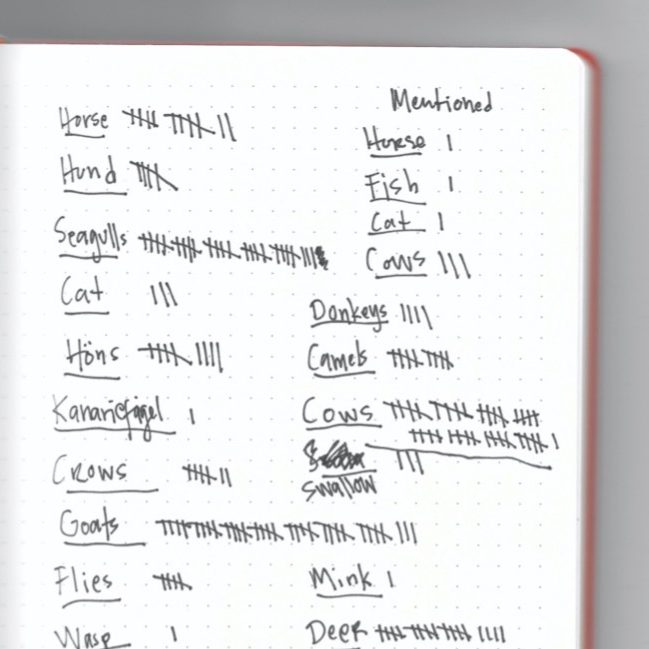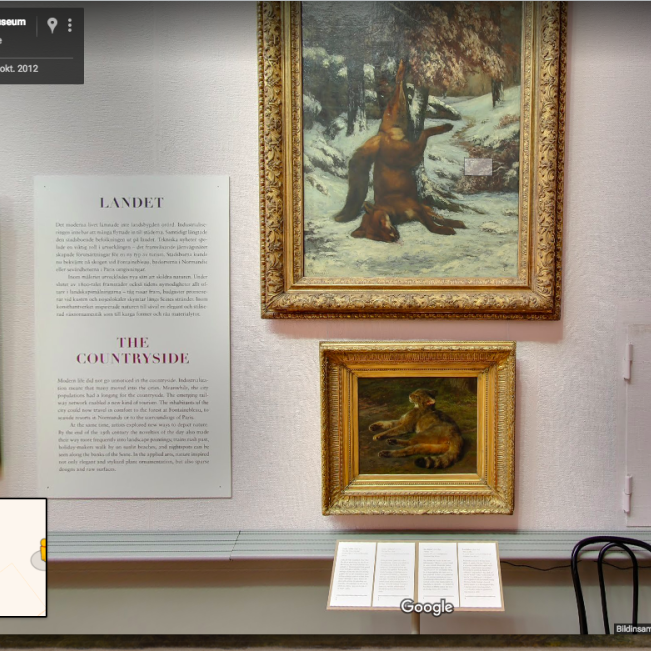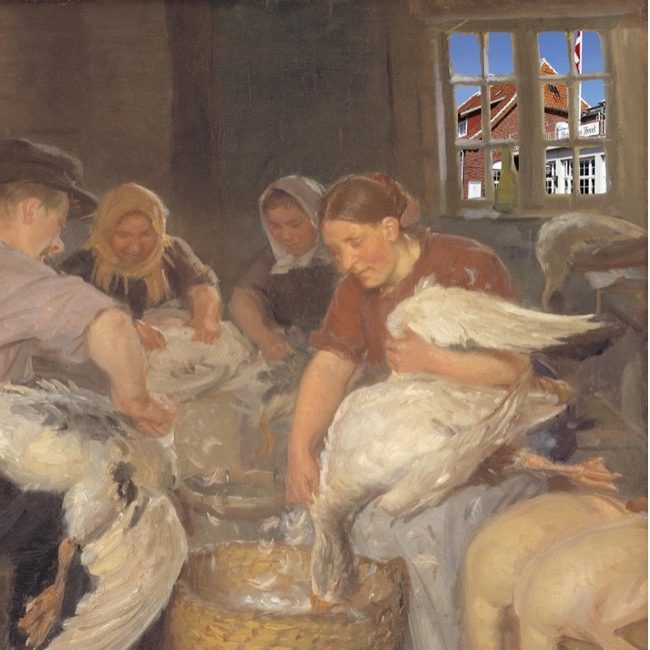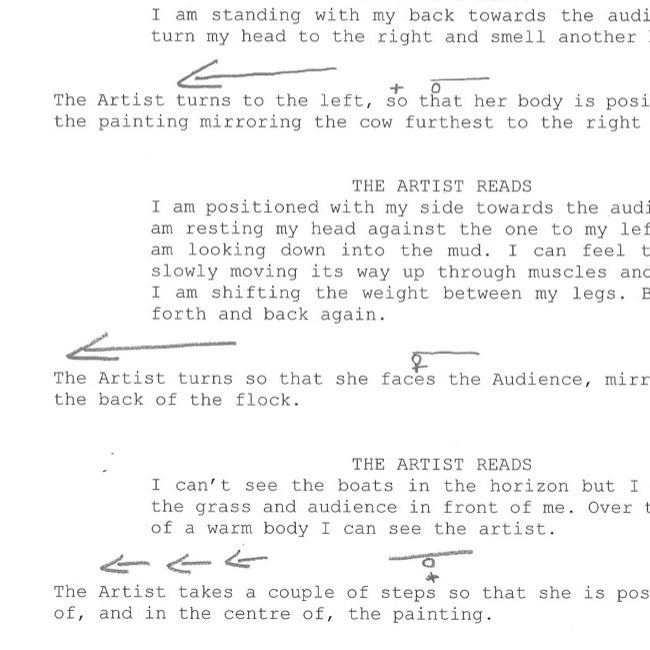RESISTANCE WITHIN THE MUSEUM FAUNA
Challenging Anthropocentrism through Counter Art Histories and Non-Human Narratives
A thesis in artistic research and critical animal studies by Dr. EvaMarie Lindahl – Edge Hill University, 2022
THE TOOLKIT
One outcome of this thesis is the development of a toolkit containing five different exercises to bring along when visiting the art museum. These exercises can also be used at a visit to a zoo-prison, or other sites that frames non-human animals. The tools are drawn from the methods and terms that have been developed throughout this project when imagining the counter narratives of the visible and invisible non-humans of the fauna of the art museum: the floating I, crowded non-human animal autobiographies, the fauna of the art museum and escaping through a window. The exercises start with representation and the counting of non-human animals on display in the exhibition halls. Are they mentioned? How are they represented? Then continues to ask for a bodily investigation of the position of the ones portrayed and a first description of what they see. Next it is time to dare to engage and feel with the violent core of a painting and then to escape the violence through a window/frame as an imaginative exercise of painting an inner picture of what we cannot see. In the next exercise a drawing of that inner picture is asked for. And finally, in the fifth exercise, the wordless crowd of the fauna of the art museum is heard through the cracks of the painting.
The toolkit aims to create a feeling with another instead of looking at others, and the courage to engage in art works from a position of empathy towards all species. Therefore, this way of ending the thesis is a hope for a beginning of a collective practice of feeling with when standing in front of painted and portrayed non-human animals.
TOOL 1
The Numbers
First let’s count the numbers, representation is key
WHERE
This exercise is written for the art museum but can just as well be done in a contemporary art gallery.
TO BRING
Pen and paper
WHAT TO DO
Go through all the paintings and sculptures (as well as other artworks if applicable) and take notes according to the following system:
1. Write down every species of non-human animal that you see in the painting, from the smallest insect or bird far away in the sky to the cat or dog in the corner closest to you. Write them down on your paper and make a note of how many of each is represented.
2. Read the title. Are the animals included in the title? Are they named? If they are, write them down separately as well.
3. Read the description. Are the animals mentioned in the description? And if they are, are they treated as metaphors for human affairs? Make a note if they are mentioned and how.
QUESTION
What does these numbers tell you? Does it affect you? If so, what can you do?
GO DEEPER IF INTERESTED
Look into the digital archives of the museum. Are the objects and individuals of the paintings categorised? If so, are the non-human animals you found mentioned and represented in the system of the archives?
TOOL 2
The Floating I
Where are we, and I, in all this?
WHERE
Stand in front of a painting that portrays several non-human animals, the painting can be placed anywhere, perhaps where you live or at an art museum.
TO BRING
Pen and paper
WHAT TO DO
Study the non-human animals portrayed. Are they close together? By themselves? Are they standing, laying, sitting, hanging? Are they turning towards or away from each other? What kind of environment surrounds them? Water, grass, sand, sky? How are they connected to earth?
1. Write individual claims from each of the portrayed animals while positioning yourself as that specific individual. Point your toes in the same direction as their feet (if they have feet), turn your face and direct your eyes in the same direction as they are. Imagine what they are seeing in the far back of the painting, beyond the frame. Imagine what it feels like to be in that painted scenery.
Write in first person and present tense. Remember to take notes of who in the painting is stating what.
2. Write a couple of collective claims that you can imagine the non-human animals experiencing together. Perhaps it is of wind or sound, perhaps it is what t is like to be on display every day.
Write as a collective we in present tense.
3. Mix the collective and individual claims into a text. Now, read them out aloud. Stand with your back against the painting while reading the collective claims. When reading the individual statements, use your notes and position yourself as that specific individual.
QUESTION
What did you experience while writing, reading and mirroring positions of individuals, as well as a group, of another species? What do you need to feel them better? What do you think they would like us to know?
GO DEEPER IF INTERESTED
Draw a map of the movements you just did and pair it with the different claims. Make a system of the text and the bodily movements so that others can repeat it.
TOOL 3
ESCAPING THROUGH A WINDOW
See the violence, then run with it!
WHERE
This exercise is written for the art museum but can just as well be done in a contemporary art gallery where violence towards non-human animals can be seen either visually or in the use of materials.
TO BRING
Pen and paper
WHAT TO DO
Choose an exhibition where many non-human animals are portrayed. Go through the exhibition and look for ongoing violence or traces of violence directed against non-human animals. Perhaps it is the scene after the shot of the hunted dear. It could be dead fish on display at the market. A whip that whips. Or preparations of the Christmas dinner in a kitchen. Choose a painting you want to study.
1. Stand in front of the painting. Study it. Where is its violent core? The hands that tear and whip. The blood. The dead body. Look at it. Keep looking at it. Try to feel it. How does the ringing in your ear sound after the shot? How hard can your heart beat during the chase? What does a whip feel like? Feel it, until you cannot stand it anymore.
2. Let your eyes wander. Keep the violence in mind while you keep investigating the painting. Look a bit to the side of the violent core. What is going on here? Who is in it? What are they doing? Try to animate the scene in your head. What happened just before and after this snapshot? Listen to the sounds. Make the hands move, the rain to fall, the feet to run, the weapon to go off.
3. Try to find an opening. A crack. Maybe it is a kitchen window, a path through the forest or a boat about to cross the ocean. Follow it. Take it. Jump through it! Run. What is on the other side? Sunlight? Silence? A beach?
4. Write a few sentences about the paintings and the core violence. Write a few sentences of what it is like at that place that you escaped to. Write a few sentences about what happened just before the scene of the painting. Write all of the sentences from the perspective of the animal who is subjected to the violence.
TOOL 4
BREAK A PHYSICAL FRAME
Draw what is outside
WHERE
This exercise is written for the art museum but can just as well be done in a contemporary art gallery.
TO BRING
Pen and paper
WHAT TO DO
1. Sit down in front of a painting that portrays non-human animals. Study it. What do you see? Who is in it? Humans and non-humans? What do they do? Are they doing it together?
2. Think of the painting as a detail of a bigger landscape or space. What happens to the right? In the far corner? Outside of the frame where the painting does not document the scene. What happens behind those trees? Is there a building to the left maybe, where those cows or humans in the painting is coming from? What happens there? Is there a path? Where does it lead?
3. Make a drawing of what is outside of the frame. Widen the painting so that it encompasses that which is behind the scene.
QUESTION
If you were the artist of this painting you are studying, what can you then see if you turn around? Are you outside? Inside your studio? What is in your hands?
GO DEEPER IF INTERESTED
Study the painting and the artist, when was it done and by who? In what setting? Try to figure out if this painting had casualties. Whose body is hidden in the materials? Who did the artist need to study to be able to paint, was the individuals studied alive?
TOOL 5
A LETTER FROM THE CROWD
Listen through the cracks
WHERE
This exercise is written for the art museum but can just as well be done in a contemporary art gallery.
TO BRING
Pen and paper
WHAT TO DO
Go back to the painting you studied in exercise 3. Now it is time to enter the painting again and search for a crowd.
1. What did the non-human animals subjected to violence tell you earlier? Read the sentences you wrote again. The sentences speak about a before and after, about what happens within the painting but also what happens outside. Time is extended, as well as space.
2. There are many more non-human animals in relation to this painting than the ones portrayed. Who are they? Are they hidden within the materials, in the paint and brushes? Are they standing outside the frame? Are they still in the artist studio, nailed to the wall so that the artist can study? Are they kept in cages? Are their bodies used as resources? Make a list of them all. They are the crowd.
3. Now search for the sounds of the wordless voices of the crowd coming to you through the cracks of the painting. Be brave. Embrace anthropomorphism. Embrace empathy. Let them tell you about their life. Imagine and listen. What do they think about the violence towards them that the painting is a testimony of? How would they like the scene of the painting to be different?
4. Pick one strong voice from the crowd that you can hear more clearly and write down their experiences and wishes. Fill in the blanks of the histories of this specific non-human animal with your own experiences of being alive in this world. What would their life be if not subjugated to humans? Write a letter together in first person and present tense addressing the visitors to the art museum. Read it out loud in front of the painting. Leave the letter in the exhibition halls when you leave.
RESISTANCE IS TO TELL WORDLESS STORIES – RESISTANCE IS TO REFUSE METAPHORICAL READINGS – RESISTANCE IS TO REFUSE DISAPPEARING IN THE DARK – RESISTANCE IS TO WRITE A COUNTER NARRATIVES – RESISTANCE IS TO CHANGE THE PERSPECTIVE – RESISTANCE IS TO FIND THE CROWD – RESISTANCE IS TO DISAPPEAR OUT A WINDOW – RESISTANCE IS TO LOOK FOR THE CRACKS – RESISTANCE IS FOUND WITHIN THE MUSEUM FAUNA
RESISTANCE IS DONE TOGETHER



